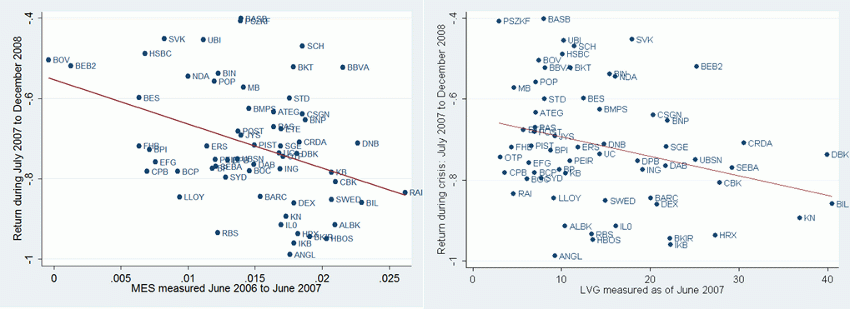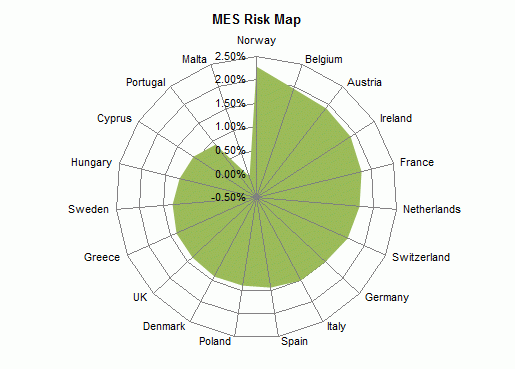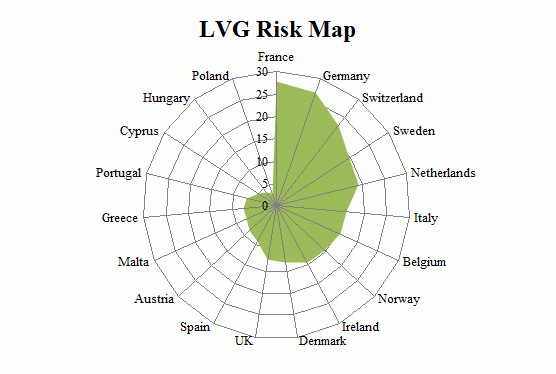In 2009, the Committee of European Banking Supervisors (CEBS) conducted an almost silent stress test including 22 systemically relevant banks. Test results were not released except for the information that all banks were able to withstand the stress scenario without falling below the 6% Tier 1 threshold.
Then, in June 2010, 91 EU banks were tested. Surprisingly, only 7 of these 91 banks failed. Though some banks had already increased their capital significantly and governments had already provided more than €450 billion in support, some obviously weak banking sectors also fared well. The stress scenarios became increasingly questioned over time as none of the Irish banks or other banks (except for Germany’s Hypo Real Estate) that eventually fell into trouble were among the banks that failed the stress tests.
In a few weeks, a similar group of banks will again be tested. However, regulators have yet to provide a clear definition as to which banks are systemically important financial institutions (SIFI’s) under some economically coherent measure of systemic risk.
In this column, we present an assessment of systemic risk of European banks using publicly available stock price data and financial statement information. Our main finding is that employing a measure of each bank’s downside risk to Europe-wide shocks and combining it with leverage can help predict in the cross-section which firms are likely to be affected the most during crises.
Our analysis builds on what a few researchers at NYU Stern School of Business have put forth as a way to identify systemically important financial institutions in the US and how to calculate their expected capital shortfall in the event of a crisis (see Acharya et al. 2010 a,b and Browneless and Engle 2011).1
To assess the systemic risk of European banks, we closely follow their approach and identify two factors that have strong predictive power for the bank’s stock price return during the financial crisis, namely:
- The Marginal Expected Shortfall (MES) which measures the performance of a bank when the market return as a whole (MSCI Europe index) experiences its worst 5% trading days within a year, and
- The bank’s (quasi-) market leverage ratio (LVG), which is its (quasi-) market value of assets2 divided by market value of equity.
Our sample comprises the publicly listed banks included in the 2010 and 2011 stress tests and adds large, publicly listed European banks which either are not EU members (for example, UBS and Credit Suisse) or which had already failed by summer 2010 (for example, Anglo Irish Bank). Overall, 63 banks are analysed as part of the sample.
Figure 1. MES and LVG as predictors of expected shortfall during July 2007 – December 2008
Figure 1 shows how well both MES and LVG, measured using one year of data up to June 2007, explain the stock price returns between July 2007 and December 2008. We employ the best fit of realised returns during the financial crisis (July 2007 to Dec 2008) as explained by both MES and LVG to come up with a “fitted” systemic risk measure and rank firms using this fit.
Table 1. Systemic risk top 10 (as per June 2007)
Ranking
|
Bank
|
Country
|
MES
|
LVG
|
1
|
Banca Italease SpA
|
Italy
|
2.30%
|
40.47
|
2
|
Deutsche Bank AG
|
Germany
|
1.81%
|
39.91
|
3
|
Natixis
|
France
|
1.73%
|
36.83
|
4
|
Commerzbank AG
|
Germany
|
2.10%
|
27.83
|
5
|
Hypo Real Estate Holding
|
Germany
|
1.82%
|
27.32
|
6
|
IKB Deutsche Industriebank AG
|
Germany
|
1.79%
|
22.31
|
7
|
Raiffeisen Bank International AG
|
Austria
|
2.62%
|
4.61
|
8
|
DnB NOR Bank ASA
|
Norway
|
2.27%
|
14.80
|
9
|
Bank of Ireland
|
Ireland
|
1.91%
|
22.24
|
10
|
Credit Agricole SA
|
France
|
1.83%
|
30.53
|
Table 1 shows the Top10 systemic banks in Europe at end of June 2007; 5 of them were either bailed out by the government during or after the crisis, or by private bank syndicates, or taken over by other banks. For example, Hypo Real Estate (ranked No.5) received about €150 billion of capital and guarantees between September 2008 and November 2009 by the German government and is now completely nationalised. Another German bank, Commerzbank AG (ranked No. 4), received about €18 billion capital support and the government now owns 25% (+1) of the common stock.3 Remarkably, 4 out of the 10 most systemic banks are German.
We aggregate the systemic risk proxy across the different banks in each country in our sample using equally weighted MES of each respective bank. Figure 2 shows an MES risk map, i.e., the countries with the most systemic banks in terms of downside exposure to a financial crisis.
Figure 2. Country MES risk map per June 2007
Belgium and, perhaps not surprisingly, Ireland feature among the top 5 countries.4 Notably, this is based on market data to compute downside risk before onset of the crisis in August 2007.
Figure 3 shows a similar LVG risk map, i.e., the countries with the most leveraged banks.
Figure 3. Country LVG map per June 2007
The empirical methodology can be readily used to construct risk rankings at different points in time. Table 2 shows the systemic risk ranking in May 2009 (when the US stress tests were released), March 2010 (before the EU stress tests were performed) and May 2011, the most recent ranking.
Noticeably, ING ranks No.6 in the May 2009 ranking. Furthermore, Dexia appears in the list of the most systemic institutions ranking No.5 in the most recent ranking (Dexia received €6.4 billion in capital and €150 billion in guarantees from government in Belgium, France, and Luxembourg in October 2008).
By May 2010, the Irish banks lead the list of systemically risky financial firms (Commerzbank and Dexia retain their high ranking too).
Interestingly, the May 2011 ranking also puts the Greek banks and banks with high Greek sovereign debt exposure into the spotlight. The banks among the top 10 systemic banks have invested 92.5% (Piraeus Bank SA), 76.6% (Marfin Popular Bank Public Co Ltd, a Cyprus bank) and 73.4% (EFG Eurobank Ergasias SA) of their sovereign debt holdings in Greek debt. Dexia (6% Greek exposure in sovereign debt holdings) and Commerzbank (4%) also show up in this ranking. The emerging role played by sovereign credit risk in determining systemically risky banks of the European banking sector is worthy of further investigation, in academic research as well as by policymakers.
Overall, the analysis in this note shows the value of using a market-based measure of downside risk and leverage in determining systemically relevant financial institutions. The most recent ranking, in particular, points to which financial institutions are most likely to have the highest expected capital shortfall if the European sovereign debt crisis further unfolds. It should be noted, though, that this methodology does not make assumptions or statements as to what causes the crisis. If, however, a default of Greece elicits a Europe-wide shock, governments in the respective countries (Greece, Ireland, Germany, France, Italy, and Cyprus) would then be required to provide further capital support for these institutions. As both Greece and Ireland have already received support by the European Financial Stability Fund (EFSF), this capital shortfall has to be added to their tab as well. In other words, if the EU Finance Ministers think about scenarios in which they let Greece default, this methodology is a useful exercise for deciding which banks they have to provide with sufficient capital before they actually let Greece go into default.
A few days ago, the European Banking Authority (EBA), the successor of CEBS, required the financial institutions participating in the stress tests to consider a scenario in which Greek bonds are factually in default. It will be interesting to reconcile their results with the ranking of systemically relevant firms provided in this column when the results are released next month.
Table 2. Systemic risk top 10
|
Ranking per May 2009
|
|
Ranking per May 2010
|
|
Ranking per May 2011
|
|
|
|
|
|
|
|
|
|
Ranking
|
Bank
|
MES
|
|
Bank
|
MES
|
|
Bank
|
MES
|
1
|
Bank of Ireland
|
9.68
|
|
Bank of Ireland
|
3.69
|
|
Irish Life and Permanent
|
4.18
|
2
|
Commerzbank AG
|
9.54
|
|
Allied Irish Banks
|
4.37
|
|
Commerzbank AG
|
1.97
|
3
|
Allied Irish Banks
|
12.97
|
|
Commerzbank AG
|
7.09
|
|
Piraeus Bank SA
|
2.97
|
4
|
Irish Life and Permanent
|
13.00
|
|
Banca Italease SpA
|
1.39
|
|
Bank of Ireland
|
4.46
|
5
|
Royal Bank of Scotland Group PLC
|
14.17
|
|
Irish Life and Permanent
|
5.05
|
|
Dexia SA
|
3.77
|
6
|
ING Groep NV
|
12.33
|
|
Dexia SA
|
6.21
|
|
IKB Deutsche Industriebank AG
|
0.74
|
7
|
Natixis
|
9.35
|
|
IKB Deutsche Industriebank AG
|
1.70
|
|
Banco Popolare SC
|
2.93
|
8
|
Dexia SA
|
8.29
|
|
Banco Popolare SC
|
5.87
|
|
Marfin Popular Bank Public Co Ltd
|
1.60
|
9
|
IKB Deutsche Industriebank AG
|
3.62
|
|
Deutsche Postbank
|
5.44
|
|
Allied Irish Banks
|
4.12
|
10
|
KBC Group SA
|
12.95
|
|
Natixis
|
7.05
|
|
EFG Eurobank Ergasias SA
|
2.29
|
The author thanks Viral Acharya of NYU-Stern for detailed discussions and guidance.
References
Acharya, Viral V, Lasse Pedersen, Thomas Philippon, and Matthew Richardson (2010a), “Measuring Systemic Risk”, Working Paper, NYU Stern.
Acharya, Viral V, Christian Brownelees, Robert Engle, Farhang Farazmand, and Matthew Richardson (2010b), “Measuring Systemic Risk”, Chapter 4 in Viral V Acharya, Thomas Cooley, Matthew Richardson and Ingo Walter (eds.), Regulating Wall Street: The Dodd-Frank Act and the New Architecture of Global Finance, John Wiley & Sons.
Brownlees, Christina and Robert Engle (2010), “Volatility, Correlation and Tails for Systemic Risk Measurement”, Working Paper, NYU-Stern.
1 A publicly available implementation of this approach for US financial institutions is provided in real time (updated weekly) on the vlab website at NYU-Stern. The website is available at http://vlab.stern.nyu.edu/welcome/risk.
2 Measured using balance-sheet data as Book value of assets – Book value of equity + Market value of equity.
3 Commerzbank AG took over Dresdner Bank AG in January 2009 and was pulled down heavily by Dresdner’s investment in subprime securities. However, since Dresdner Bank AG was taken over by Allianz AG in 2002, there is no market data available for Dresdner Bank AG and it is therefore not included in our sample.
4 The Austrian government also provided substantial support to their banks, e.g. nationalising the municipality lender Kommunalkredit in 2008 and Hypo Group Alpe Adria in 2009.





